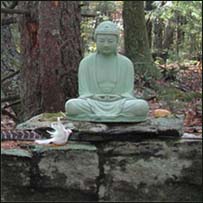|
|
 |
Please support Dharma Seed with a 2025 year-end gift.
Your donations allow us to offer these teachings online to all.

|

|

|
The greatest gift is the
gift of the teachings
|
|

|
| |
|
Dharma Talks
|
2023-07-17
The Nature of Awakening: Traditional and Contemporary Paths of Awakening
68:04
|
|
Donald Rothberg
|
|
|
We examine first the Buddha’s teachings about awakening, We see how he understands the process as involving two processes. We are mindful of and work through what gets in the way of touching our natural awakening—greed, hatred, and delusion (or the two forms of reactivity—grasping after the pleasant and pushing away the unpleasant, along with ignorance about the nature of impermanence, reactivity or Dukkha, and not-self). We also develop those qualities which both support and manifest awakening, qualities identified in the teaching of the Seven Factors of Awakening. We see further how the Buddha at times identified the nature of awakened awareness as “signless, boundless, all-luminous,” and trace similar accounts of awakened awareness in the Thai Forest tradition and Tibetan Dzogchen and Mahāmudrā.
Then we ask the question about whether these wonderful teachings and associated practices are sufficient for awakening in the contemporary world. We point to how such teachings and practices are crucial but also need to be complemented by and integrated with a contemporary map of awakening, identifying forms of contemporary conditioning (and greed, hatred, and delusion) that are not found in the traditional account. Broadly speaking, we can identify two inter-related core areas—a first identifying more “psychological” conditioning, and more “social” conditioning (for example, around gender, race, sexual orientation, age, etc.). The talk is followed by discussion.
|
|
Spirit Rock Meditation Center
:
Spirit Rock Live: Monday Night with Donald Rothberg
|
|
|
2023-07-15
Q&A
14:42
|
|
Ajahn Sucitto
|
|
|
00:05 Before encountered the dhamma I always thought that problems required solutions. You say they need spaciousness, openness and patience. What then is the place for mental strategies and solutions.
|
|
Gaia House
:
Unrestricted Awareness
|
|
|
2023-07-14
Q&A
48:38
|
|
Ajahn Sucitto,
Laura Bridgman
|
|
|
00:05 Q1 (AS) You talked about protection during the QiGong. How does protection happen without closure? 09:39 Q2 (LB) Could you explain how the citta can cleanse sankaras? 17:05 (AS response). 36:04 Q3 (AS) Given that I struggle to maintain focus even on a narrow object, it’s very hard to bring the whole body into awareness . Any hints? 45:02 (LB response).
|
|
Gaia House
:
Unrestricted Awareness
|
|
|
2023-07-13
Guided Meditation: Images and the Energy Body
24:23
|
|
Victor von der Heyde
|
|
|
This meditation uses any personal images people might have from considering what might constitute a beautiful life for them, and considering Naikan questions (in this case what one has received from the world, what one has given, what problems or difficulties one thinks one has caused), and tuning in to the impact these images have on the energy body. The later part of the meditation focusses on putting images aside. It’s partly a practice to develop appreciation, to see the felt impact of one’s actions, and partly - towards the end - an exercise in letting go of images.
|
|
Australian Insight Meditation Network
:
Seeing That Frees
|
|
|
2023-07-12
Cultivating Wise Speech 1
61:26
|
|
Donald Rothberg
|
|
|
We look first at the importance of wise speech, the way that it forms an integral part of the path of awakening, the way that it is often underdeveloped in Western Buddhist practice, for various reasons, and some of the challenges of speech. We then examine three aspects of wise speech practice: (1) developing presence in the midst of communication; (2) working with the four guidelines for skillful speech developed by the Buddha; and (3) integrating our practice to be mindful and skillful with thoughts, emotions, and body states with our speech practice. The talk is followed by discussion, focused especially on some challenging relational and speech situations.
|
|
Spirit Rock Meditation Center
:
Monday and Wednesday Talks
|
|
|
|
|